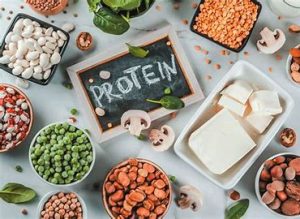There’s a big emphasis on plant based diets and eating less meat, and of course eating more plants, is better for most of us, but unless you make the right swaps, you could end up with deficiencies, and a less healthy diet.
The food manufacturers really want to sell us their plant based food alternatives, but the majority of these are not healthy, they’re just convenient. Eating more plants doesn’t mean fake meat, or spending hours in the kitchen. You can use tinned beans and sachets of lentils and quinoa / amaranth.
Some people’s digestive systems are not suited to eating more plants and beans and can cause a lot of bloating and discomfort. Building up slowly and cooking beans well, ideally in a pressure cooker can help.
Here are the key points:
Ideally everyone should have a least one portion of protein per day – two portions if still growing, elderly, pregnant or being physical. For every one portion of meat protein, you need two portions of plant protein, which means you should be looking at 2-3 portions of plant proteins per day if reducing meat.
Plant proteins are beans (black beans are great) and pulses such as lentils; tofu or tempeh; nuts and seeds; and Quinoa or Amaranth (ancient seed grains). Using nuts and seeds as a portion isn’t wise, as the calorific value is too high, but you can use these to supplement other proteins. If you are still eating eggs or dairy these are good sources of protein.
You still need essential fats from Flax seeds and cold pressed flax oil, walnuts, pumpkin seeds, chia seeds and avocados. In addition you will need to supplement with plant based omega 3 algae unless you eat some oily fish.
You will need Vitamin B12 which you can supplement – liquid B12 under the tongue is ideal, and use Nutritional Yeast which is fortified with B12. Seaweeds also contain B12
You will need more iron. Many iron supplements are harsh on the stomach and constipating, but iron bisglycinate is more readily absorbed. Spirulina is another great source of iron and B12 which you can add to smoothies if you like the earthy taste.
Iron is best absorbed from meat as veg sources of iron are much lower, but vegetarian iron foods are green leafy vegetables, prunes, dates, molasses, very dark chocolate, nuts, seeds and lentils – all of which are absorbed better if they are eaten with foods high in vitamin C such as raw pepper, watercress and rocket, and berries.
A typical day:-
Breakfast – Nut butter or avocado on toast, or lentil pate on toast, or smoothie with nut butter, avocado and coco powder and banana
Lunch – Soup with beans and humus on bread or crackers, or lentil and quinoa salad with avocado and seeds
Dinner – Bean casserole with spinach, chestnuts and field mushrooms with Quinoa or Amaranth, or Tofu stir fry with seaweed, cashew nuts and wild rice, or roasted vegetables with tahini dressing and sliced tempeh
For quickness you can use bean burgers or nut roasts, but make sure the ingredients are recognisable and natural
Snack on a few nuts and seeds and very dark chocolate plus fresh fruit
Find out more sam@whatseatingyou.co.uk 07767260374 www.whatseatingyou.co.uk

